Rural Roots of Old
Jane-Finch
This vintage calendar was
generously donated by Beth Bow of Brookview Middle School in February
2005.
Front and back cover

 Inset: "Like many other
areas in Southern Ontario, Jane/Finch was once a small farming
district north of the City of Toronto. For nearly 150 years farms and
orchards dotted the landscape where high rises and shopping plazas now
stand. The developing Jane/Finch Community now takes time to remember
our rural beginnings."
January
Inset: "Like many other
areas in Southern Ontario, Jane/Finch was once a small farming
district north of the City of Toronto. For nearly 150 years farms and
orchards dotted the landscape where high rises and shopping plazas now
stand. The developing Jane/Finch Community now takes time to remember
our rural beginnings."
January

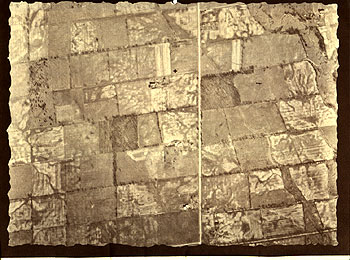 Inset: "JANE STREET
SHOWING FINCH AVENUE AND FARMLAND NORTH, 1942: Until very recently the
area around Jane/Finch was a small farming community which had existed
for over a century without undergoing any major physical changes. In
the late 1950's it was prepared for residential and commercial
development. Today our community boasts of over 55,000 people, many of
whose homes have been built within the area covered by this 1942
aerial photograph."
February
Inset: "JANE STREET
SHOWING FINCH AVENUE AND FARMLAND NORTH, 1942: Until very recently the
area around Jane/Finch was a small farming community which had existed
for over a century without undergoing any major physical changes. In
the late 1950's it was prepared for residential and commercial
development. Today our community boasts of over 55,000 people, many of
whose homes have been built within the area covered by this 1942
aerial photograph."
February

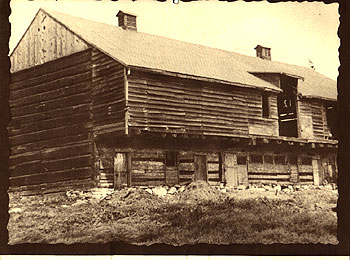 Inset: "DALZIEL'S
PENNSYLVANIAN GERMAN BANK BARN, BUILT 1809: Johannes Schmidt of
Pennsylvania settled in the Jane/Steeles area in 1808 and built this
large bank barn the following year as part of his farm. The Dalziels
bought the farm in 1828 and carried on a saw milling business which
became the centre of industry for the community. In 1954 the barn was
converted to a public museum and later became one of the original
buildings situated in the Black Creek Pioneer Village."
March
Inset: "DALZIEL'S
PENNSYLVANIAN GERMAN BANK BARN, BUILT 1809: Johannes Schmidt of
Pennsylvania settled in the Jane/Steeles area in 1808 and built this
large bank barn the following year as part of his farm. The Dalziels
bought the farm in 1828 and carried on a saw milling business which
became the centre of industry for the community. In 1954 the barn was
converted to a public museum and later became one of the original
buildings situated in the Black Creek Pioneer Village."
March

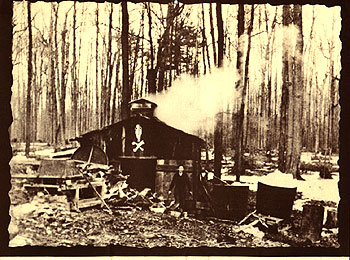 Inset: "WILBERT SNIDER'S
MAPLE SUGAR HOUSE, C. 1945: Every spring for nearly 150 years sap was
tapped from the trees in this dense sugar bush east of the Black
Creek. The maple sugar house shown here adorned with the skull and
cross bones of a horse stood where Sentinel road and Grandravine Drive
now meet."
April
Inset: "WILBERT SNIDER'S
MAPLE SUGAR HOUSE, C. 1945: Every spring for nearly 150 years sap was
tapped from the trees in this dense sugar bush east of the Black
Creek. The maple sugar house shown here adorned with the skull and
cross bones of a horse stood where Sentinel road and Grandravine Drive
now meet."
April
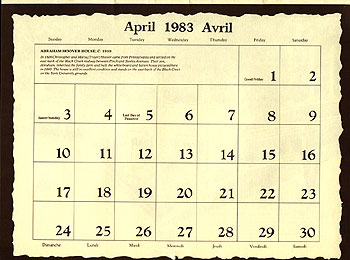
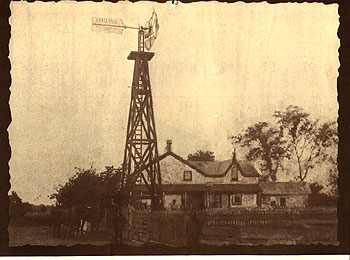 Inset: "ABRAHAM HOOVER
HOUSE, C. 1910: In 1826 Christopher and Maria (Troyer) Hoover came
from Pennsylvania and settled on the east bank of the Black Creek
midway between Finch and Steeles Avenues. Their son, Abraham,
inherited the family farm and built the white board and batten house
pictured here in 1845. The house is still in excellent condition and
stands on the east bank of the Black Creek on the York University
grounds."
May
Inset: "ABRAHAM HOOVER
HOUSE, C. 1910: In 1826 Christopher and Maria (Troyer) Hoover came
from Pennsylvania and settled on the east bank of the Black Creek
midway between Finch and Steeles Avenues. Their son, Abraham,
inherited the family farm and built the white board and batten house
pictured here in 1845. The house is still in excellent condition and
stands on the east bank of the Black Creek on the York University
grounds."
May

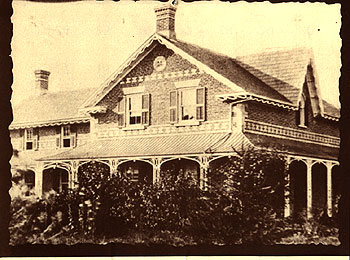 Inset: "DALZIEL HOME, C.
1875: In 1870 James Dalziel built this large house just north of the
family's Bank Barn which is now part of the Black Creek Pioneer
Village. It was then in the community of Kaiserville which also housed
a saw mill, blacksmith shop, carpenter's shop and a wagon maker's
shop. The house is still standing on Jane Street north of Steeles and
is the home of Mrs. Jean Agnew, a direct descendent of the original
Dalziels."
June
Inset: "DALZIEL HOME, C.
1875: In 1870 James Dalziel built this large house just north of the
family's Bank Barn which is now part of the Black Creek Pioneer
Village. It was then in the community of Kaiserville which also housed
a saw mill, blacksmith shop, carpenter's shop and a wagon maker's
shop. The house is still standing on Jane Street north of Steeles and
is the home of Mrs. Jean Agnew, a direct descendent of the original
Dalziels."
June

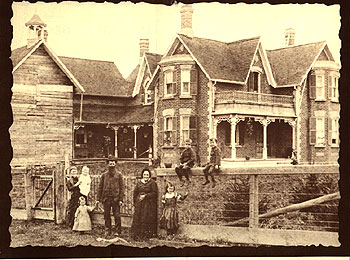 Inset: "JOHN C. SNIDER
AND FAMILY IN FRONT OF THEIR FARM HOUSE, SOUTH OF FINCH, IN 1891: The
property which stretched between Keele and Jane Streets, was
originally settled by John C.'s grandfather, Samuel Snider, in 1806
and remained in the family until the residential development of the
1950's. The young spruce trees seen in the bottom right of the photo
are now nearly 100 years old and stand in Sentinel park north of Elia
Junior High School on Sentinel road."
July
Inset: "JOHN C. SNIDER
AND FAMILY IN FRONT OF THEIR FARM HOUSE, SOUTH OF FINCH, IN 1891: The
property which stretched between Keele and Jane Streets, was
originally settled by John C.'s grandfather, Samuel Snider, in 1806
and remained in the family until the residential development of the
1950's. The young spruce trees seen in the bottom right of the photo
are now nearly 100 years old and stand in Sentinel park north of Elia
Junior High School on Sentinel road."
July

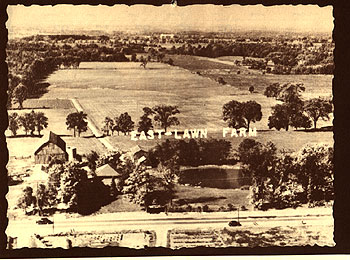 Inset: "EAST LAWN FARM,
LOOKING WEST PAST KEELE STREET, C. 1948: In the early 1900's Samuel
Snider's original log cabin was moved to this site on Keele Street
south of Finch to provide the first home for his great-grandson,
Wilbert. In winter Wilbert Snider's frozen pond became the favourite
skating spot in the entire area."
August
Inset: "EAST LAWN FARM,
LOOKING WEST PAST KEELE STREET, C. 1948: In the early 1900's Samuel
Snider's original log cabin was moved to this site on Keele Street
south of Finch to provide the first home for his great-grandson,
Wilbert. In winter Wilbert Snider's frozen pond became the favourite
skating spot in the entire area."
August
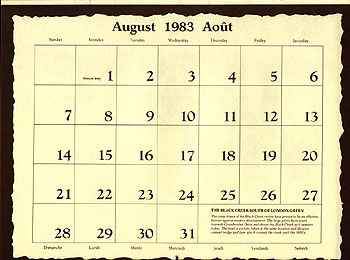
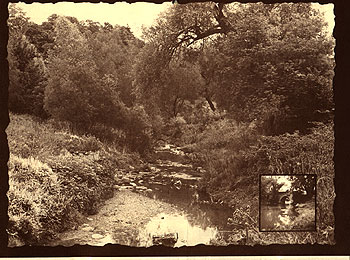 Inset: "THE BLACK CREEK
SOUTH OF LONDON GREEN: The steep slopes of the Black Creek ravine have
proven to be an effective barrier against modern development. The
large photo faces south towards Grandravine Drive and shows the Black
Creek as it appears today. The inset is a photo taken at the same
location and shows a cement bridge and dam which crossed the creek
until the 1950's"
September
Inset: "THE BLACK CREEK
SOUTH OF LONDON GREEN: The steep slopes of the Black Creek ravine have
proven to be an effective barrier against modern development. The
large photo faces south towards Grandravine Drive and shows the Black
Creek as it appears today. The inset is a photo taken at the same
location and shows a cement bridge and dam which crossed the creek
until the 1950's"
September
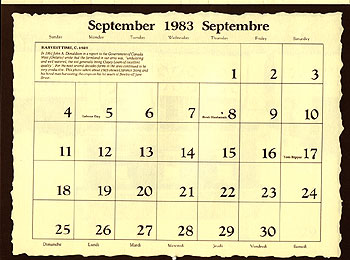
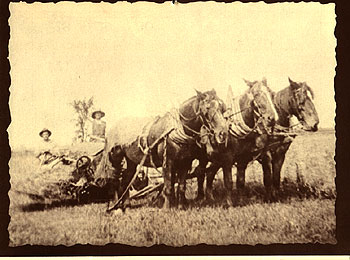 Inset: "HARVEST TIME, C.
1925: In 1861 John A. Donaldson in a report to the Government of
Canada West (Ontario) wrote that the farmland in our area was,
"undulating and well watered, the soil generally being Clayey Loam of
excellent quality". For the next several decades farms in the area
continued to be very productive. This photo taken about 1925 shows
Clarence Stong and his hired man harvesting the crops on his lot south
of Steeles off Jane Street"
October
Inset: "HARVEST TIME, C.
1925: In 1861 John A. Donaldson in a report to the Government of
Canada West (Ontario) wrote that the farmland in our area was,
"undulating and well watered, the soil generally being Clayey Loam of
excellent quality". For the next several decades farms in the area
continued to be very productive. This photo taken about 1925 shows
Clarence Stong and his hired man harvesting the crops on his lot south
of Steeles off Jane Street"
October

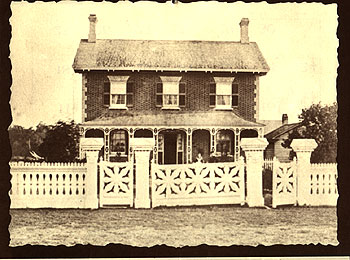 Inset: "JACOB STONG
FARMHOUSE, BUILT C. 1857: Jacob, the eldest son of Daniel and
Elizabeth Stong was born in the log cabin that now stands in the Black
Creek Pioneer Village. Jacob Stong became a prominent member of our
community in the 19th Century. He was a farmer, sawmill owner, Justice
of the Peace and in 1879 was appointed an original director and Judge
of the Canadian National Exhibition. His house still stands on the
southwest corner of Keele and Steeles."
November
Inset: "JACOB STONG
FARMHOUSE, BUILT C. 1857: Jacob, the eldest son of Daniel and
Elizabeth Stong was born in the log cabin that now stands in the Black
Creek Pioneer Village. Jacob Stong became a prominent member of our
community in the 19th Century. He was a farmer, sawmill owner, Justice
of the Peace and in 1879 was appointed an original director and Judge
of the Canadian National Exhibition. His house still stands on the
southwest corner of Keele and Steeles."
November
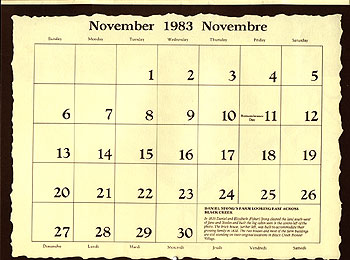
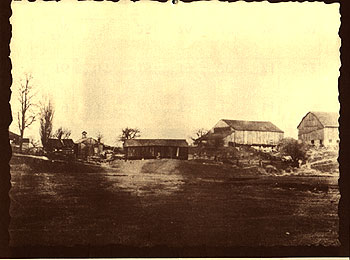 Inset: "DANIEL STONG'S
FARM LOOKING EAST ACROSS BLACK CREEK: In 1816 Daniel and Elizabeth
(Fisher) Stong cleared the land south-west of Jane and Steeles and
built the log cabin seen in the centre-left of the photo. The brick
house, further left, was built to accommodate their growing family in
1832. The two houses and most of the farm buildings are still standing
on their original locations in Black Creek Pioneer Village."
December
Inset: "DANIEL STONG'S
FARM LOOKING EAST ACROSS BLACK CREEK: In 1816 Daniel and Elizabeth
(Fisher) Stong cleared the land south-west of Jane and Steeles and
built the log cabin seen in the centre-left of the photo. The brick
house, further left, was built to accommodate their growing family in
1832. The two houses and most of the farm buildings are still standing
on their original locations in Black Creek Pioneer Village."
December

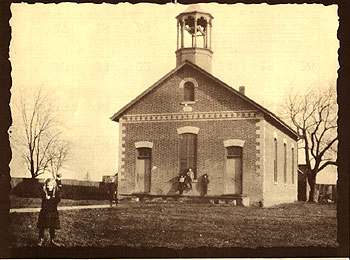 Inset: "SS NO. 18, NORTH
YORK ELIA PUBLIC SCHOOL: As early as 1834 school sessions for children
living west of Jane Street were being held in a log farm house on
Weston Road South of Finch. Another school was built in Elia, on the
north-west corner of Keele and Finch and served the community east of
Jane Street. In 1873 this new Elia Public School was built across the
road on the east side of Keele Street and continued to provide classes
until 1956. Today the site is covered by a self-serve gas station."
Inset: "SS NO. 18, NORTH
YORK ELIA PUBLIC SCHOOL: As early as 1834 school sessions for children
living west of Jane Street were being held in a log farm house on
Weston Road South of Finch. Another school was built in Elia, on the
north-west corner of Keele and Finch and served the community east of
Jane Street. In 1873 this new Elia Public School was built across the
road on the east side of Keele Street and continued to provide classes
until 1956. Today the site is covered by a self-serve gas station."
|